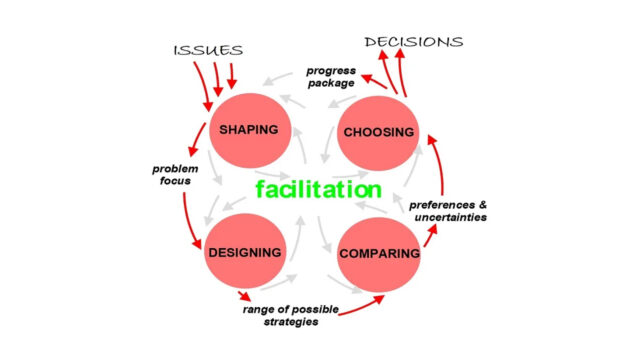
Taking responsibility for complexity (section 3.3.6): Sense making for common ground
This article is part of section 3.3 of a series of articles featuring the ODI Working Paper Taking responsibility for complexity: How implementation can achieve results in the face of complex problems.
While it is crucial to ensure a wide range of perspectives on an issue are heard, progress on governing complex issues requires that programmes work towards a shared framing of the problem at hand. As argued above, decision-making in complexity requires considerable interpretation and judgement – weighing up the relative importance of different perspectives and aspects. This fundamental steer for policy and decisions must not be left entirely up to one decision-maker’s discretion; underlying assumptions must also be open to examination and challenge1 and multiple perspectives and types of knowledge must be included and weighed up in an inclusive manner.
It is therefore high priority to ensure that framing and conceptualising a problem is an inclusive, communicative process. It is likely that this will need to be carried out with a variety of actors, including not just policy actors but also those from academic disciplines and professional groups. Citizens and others need to be able to challenge and interrogate the positions of expert outsiders and/or domestic elites2.
‘Boundary concepts’ facilitate collective processes of sense making and attempts to bridge perspectives and work towards shared understandings of problems. These are ideas that are relatively loose but refer to the same object, phenomenon or quality across different disciplines, professional groups or perspectives, with deep and specific meanings within each group or discipline3. As opposed to strictly defined terms, which can be agreed between small groups in order to shape highly coherent approaches to learning or acting, boundary concepts allow ‘weak ties’ for discussion, communication and negotiation across boundaries and between groups – permitting some level of coordination without consensus. On the downside, this vagueness allows space for very different interpretations, hiding conflicting ideals and practices. Some examples of boundary concepts are efficiency, vulnerability and control of natural resources.
New concepts and models can be jointly negotiated in order to provide a common approach to implementation. Molle4 uses the example of Integrated Water Resources Management (IWRM), which was conceived of in the face of a chaotic situation with the aim of promoting coordinated responses from sectors, ministries and professional groups, which were otherwise fragmented or unintegrated. IWRM represented the ‘photo negative’ of this situation, which was persuasive for all parties but also glossed over tensions somewhat, and in some cases has been used by various interests to legitimise their actions (although they often simply carry on doing what they were doing before). Nonetheless, these kinds of concept and framework represent a first stage in addressing complex issues by offering an acceptable common ground for stakeholders to engage.
There are also various calls to focus on producing ‘boundary objects,’ which will be owned by various actors and have real operational implications – for example shared models, scenarios, assessments or standards. Cash et al.5 show how a co-produced model of the dynamics of acid rain proved critical in fostering an agreement on collaboration to address it. This chimes with Ostrom’s6 emphasis on the role of a ‘joint image’ of a problem to serve as a basis for negotiations about future action, and literature on linking science and policy, which shows it will be important to move from boundary concepts to boundary objects by negotiating concrete, operational structures and processes around ideas7.
Next part (section 3.3.7): Facilitation and mediation.
See also these related series:
- Exploring the science of complexity
- Planning and strategy development in the face of complexity
- Managing in the face of complexity.
Article source: Jones, H. (2011). Taking responsibility for complexity: How implementation can achieve results in the face of complex problems. Overseas Development Institute (ODI) Working Paper 330. London: ODI. (https://www.odi.org/sites/odi.org.uk/files/odi-assets/publications-opinion-files/6485.pdf). Republished under CC BY-NC-ND 4.0 in accordance with the Terms and conditions of the ODI website.
References and notes:
- Klein, G., Moon, B. and Hoffman, R. (2006). ‘Making Sense of Sensemaking: Alternative Perspectives.’ Intelligent Systems 21(4): 70-73. ↩
- van der Hove, S. (2000). ‘Participatory Approaches to Environmental Policy-making: The European Commission Climate Policy Process as a Case Study.’ Ecological Economics 33(3): 457-472. ↩
- Löwy, I. (1992). ‘The Strength of Loose Concepts – Boundary Concepts, Federative Experimental Strategies and Disciplinary Growth: The Case of Immunology.’ History of Science 30: 371-396. ↩
- Molle, F. (2008). ‘Nirvana concepts, Narratives and Policy Models: Insights from the Water Sector.’ Water Alternatives 1(1): 131-156. ↩
- Cash, D., Clark, W., Alcock, F., Dickson, N., Eckley, N., Guston, D., Jager, J. and Mitchell, R. (2003). ‘Knowledge Systems for Sustainable Development’, The Proceedings of the National Academy of Sciences 100(14): 8086–91. ↩
- Ostrom, E. (1990). Governing the Commons: The Evolution of Institutions for Collective Action. Cambridge: Cambridge University Press. ↩
- Allen, D. (2009). ‘From Boundary Concept to Boundary Object: The Practice and Politics of Care Pathway Development.’ Social Science & Medicine 69(3): 354-361. ↩





